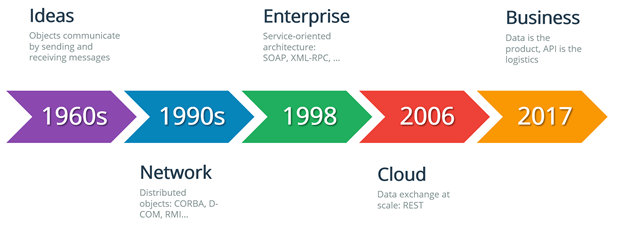1 Executive Summary
From what used to be a purely technical concept created to make developers’ lives easier, Application Programming Interfaces (APIs) have evolved into one of the foundations of modern digital business. Today, APIs can be found everywhere – at homes and in mobile devices, in corporate networks and in the cloud, even in industrial environments.
APIs allow developers to create applications faster by enabling support for modern architectures like microservices. They ensure that applications from different vendors can exchange data seamlessly, orchestrate massive cloud infrastructures and global networks of smart devices. They enable business communications with suppliers, service providers, and customers. APIs can also unlock numerous new business models for companies to offer their core services in innovative ways, to reach new customer bases or to streamline sales and services across multiple channels.
The term itself, as well as the general concept of designing applications as loosely coupled building blocks that communicate over abstract interfaces appeared first in the 1960s. The concept was driven by the growing complexity of software and the resulting need to hide that complexity from developers, allowing them to focus on business logic of their applications and reuse existing code for handling less important things.
The next stage of the API evolution came in the 1990s when the concept was expanded to support remote API calls over network protocols. This allowed developers to provide or consume application functions across heterogeneous platforms, allowing even greater flexibility in designing complex software using different frameworks and technologies. On an even larger, internet-wide scale, this led to the emergence of Web Services, object-oriented interfaces for exchanging data over the standard HTTP protocol.
The breakthrough came in the early 2000s when the Representational State Transfer (REST) emerged as an innovative architectural style for developing web services. This approach was an extremely fast, scalable and lean alternative to earlier enterprise standards like SOAP. Now, everyone could create and publish their APIs very quickly, using existing standard protocols and formats (like HTTP, XML, and JSON) and existing tools.
APIs are now powering the logistics of delivering digital products to partners and customers. Almost every software product or cloud service now comes with a set of APIs for management, integration, monitoring or a multitude of other purposes. The rapid adoption of REST APIs also coincided with the exponential growth of cloud computing and mobile device proliferation, where they were the perfect medium to enable integrations between these heterogeneous systems and facilitate data exchange on a massive scale.
Modern graphical user interfaces and websites are becoming increasingly reliant on APIs as well, to ensure that user experience remains consistent across any device or client application. In fact, every action performed by a website visitor, mobile app user or even by a smart device involves at least one API call to a remote backend system.

This sing growth clearly indicates that APIs are no longer just “an IT thing” – they have a very tangible impact on nearly every business’s operational efficiency, scalability, and agility and in the end, directly influence its profitability.
How Amazon and others transformed with APIs.
Amazon transformed its own internal IT architecture by basing everything on APIs and a service-oriented architecture (SOA) which laid the ground for its current dominance or retail and cloud services. Amazon engineers restructured the existing infrastructure into stand-alone components that developers could access freely. Payments, processing, messaging, storage, and databases were reduced to basic functionality and accessed by anyone in the company through a store of APIs. Google also used freely available APIs to make its range of mobile apps dominant in the fields of search, mapping, and email.
Much of the development work in APIs was done by large software companies that used them to build market share for their own services. The lessons learned however are now useful to any business that wants to move to a faster, leaner, and more flexible way of working by using APIs internally and externally. APIs make it easier to integrate and connect people, places, systems, data, and algorithms to create new experiences, products, services and business models.
As the experience of the IT giants shows, APIs can transform a business to give competitive advantage. By allowing third parties and members of a company’s ecosystem access to development and internal applications through APIs, businesses are opening development co-operation that can lead to greater innovations and better customer experience. By constructing an API architecture service layer, organizations should be better placed for effective digital transformation.




































